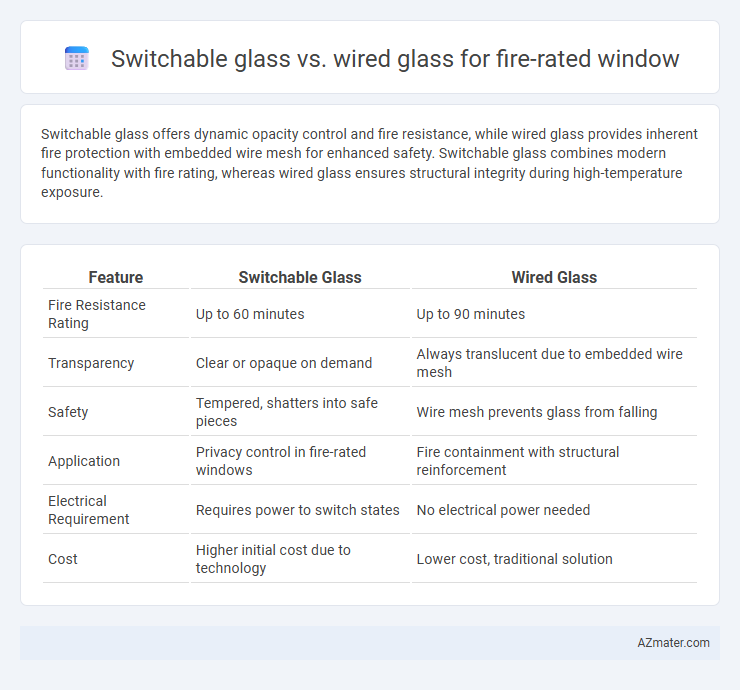Switchable glass offers dynamic opacity control and fire resistance, while wired glass provides inherent fire protection with embedded wire mesh for enhanced safety. Switchable glass combines modern functionality with fire rating, whereas wired glass ensures structural integrity during high-temperature exposure.
Table of Comparison
| Feature | Switchable Glass | Wired Glass |
|---|---|---|
| Fire Resistance Rating | Up to 60 minutes | Up to 90 minutes |
| Transparency | Clear or opaque on demand | Always translucent due to embedded wire mesh |
| Safety | Tempered, shatters into safe pieces | Wire mesh prevents glass from falling |
| Application | Privacy control in fire-rated windows | Fire containment with structural reinforcement |
| Electrical Requirement | Requires power to switch states | No electrical power needed |
| Cost | Higher initial cost due to technology | Lower cost, traditional solution |
Introduction to Fire-Rated Windows
Fire-rated windows are engineered to contain and slow the spread of fire, featuring materials that maintain structural integrity under extreme heat. Switchable glass offers modern functionality by toggling between transparent and opaque states while meeting fire safety standards. Wired glass, traditionally used in fire-rated applications, contains embedded metal mesh to resist shattering and heat penetration during fire exposure.
What is Switchable Glass?
Switchable glass, also known as smart glass, is an advanced glazing technology that changes from opaque to transparent when an electrical current is applied, offering privacy control and energy efficiency. In fire-rated windows, switchable glass provides an innovative way to maintain visibility and light transmission without compromising fire resistance, as it is combined with fire-rated laminated glass layers. Compared to wired glass, which contains embedded metal wires to prevent shattering, switchable glass delivers modern aesthetic benefits and dynamic functionality while meeting fire safety standards.
What is Wired Glass?
Wired glass is a type of fire-rated glass embedded with a metal wire mesh that helps hold the glass fragments in place during heat exposure, enhancing fire resistance and safety. It is commonly used in fire-rated windows and doors to prevent the spread of fire and smoke while maintaining structural integrity. Unlike switchable glass, wired glass offers passive fire protection without electronic controls or privacy functions.
Fire Resistance: Switchable Glass vs Wired Glass
Switchable glass typically offers limited fire resistance compared to wired glass, as the embedded electrical components and laminated layers can compromise structural integrity under high heat. Wired glass contains a metal wire mesh that helps maintain its shape and prevent shattering during a fire, providing better containment of flames and smoke. Fire-rated windows with wired glass generally meet stricter fire safety standards, making them more reliable for fire resistance applications.
Safety and Impact Performance Comparison
Switchable glass offers enhanced safety through its ability to instantly turn opaque, providing privacy without compromising fire resistance, while wired glass maintains fire containment due to embedded wire mesh that prevents glass spalling during high heat exposure. In impact performance, switchable glass often incorporates laminated layers that improve shatter resistance and reduce injury risk, whereas wired glass, despite its fire rating, tends to be more brittle and prone to fragmentation upon impact. Both materials meet fire rating standards, but switchable glass provides superior impact safety, making it a preferred choice for applications requiring both fire protection and high-impact durability.
Privacy and Light Control Differences
Switchable glass offers dynamic privacy and light control by instantly changing from transparent to opaque with an electrical switch, making it ideal for adaptable fire-rated window applications. Wired glass provides fixed privacy due to its embedded wire mesh but limits light transmission and cannot adjust opacity for varying privacy needs. The switchable glass enhances versatility in fire-rated windows by allowing precise control over visibility and daylight without compromising fire safety standards.
Aesthetics and Design Flexibility
Switchable glass offers superior aesthetics and design flexibility for fire-rated windows by providing clear, opaque, and privacy modes with a simple electric switch, enabling dynamic interior spaces and seamless modern designs. Wired glass, while durable and fire-resistant, features a fixed, industrial appearance with embedded wire mesh that limits transparency and design adaptability. The sleek, frameless look and customizable size options of switchable glass enhance architectural innovation compared to the traditional, utilitarian design of wired glass.
Energy Efficiency Insights
Switchable glass offers superior energy efficiency for fire-rated windows by actively controlling solar heat gain and glare through electrochromic technology, reducing HVAC loads and enhancing occupant comfort. Wired glass, while fire-resistant, lacks dynamic control over light and heat transfer, leading to higher energy consumption and less effective thermal regulation. Investing in switchable glass improves building energy performance and supports sustainability goals by optimizing daylight management and insulating properties.
Installation and Maintenance Considerations
Switchable glass for fire-rated windows requires precise electrical wiring integration and specialized installation to ensure proper functionality and fire compliance, often necessitating professional expertise. Wired glass is typically easier to install due to its straightforward mounting but demands regular inspections for wire mesh integrity and potential corrosion to maintain fire resistance. Maintenance for switchable glass involves monitoring electrical components and controls, whereas wired glass requires thorough cleaning and prompt repair of any wire damage to preserve safety standards.
Cost Comparison and Long-term Value
Switchable glass for fire-rated windows typically costs 30-50% more upfront than wired glass due to its advanced technology and integration requirements. Wired glass offers a lower initial investment but may incur higher maintenance and replacement expenses over time due to lower durability and limited functionality. Over the long term, switchable glass provides greater value through energy savings, enhanced safety features, and reduced need for replacements, making it a cost-effective solution despite the higher initial expenditure.

Infographic: Switchable glass vs Wired glass for Fire-rated window
 azmater.com
azmater.com